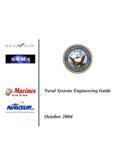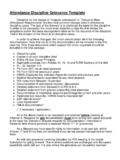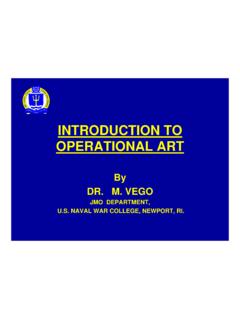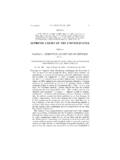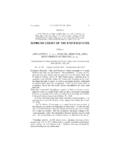Transcription of AIR WARt COLLEGE - Defense Technical Information Center
1 AD lDDDA24-429-AIR WARt COLLEGERESEARCH REPORTTHE ARMY'S ORGANIZATIONAL INSPECTION PROGRAMDTICEECTELIEUTENANT COLONEL WILLIAM R. SINCLAIR, USA199091-12341I~~~~~ 111 "i' Pl 111 B!l II Ci ~AIR UNIVERSITY RELIE:[ DISIRIIONUNITED STATES AIR FORCEMAXWELL AIR FORCE BASE, ALABAM UNLIMITED91i 10 3 111 AIR WAR COLLEGEAIR UNIVERSITYTHE ARMY'S ORGANIZATIONAL INSPECTION PROGRAMbyWilliam R. SinclairLieutenant Colonel, USAA Defense ANALYTICAL STUDY SUBMITTED TO THE FACULTYINFULFILLMENT OF THE CURRICULUM REQUIREMENTA dvisor: Colonel Wayne NelsonMAXWELL AIR FORCE BASE, ALABAMAAPRIL 1990 TABLE OF CONTENTSDISCLAIMER .. iEXECUTIVE SUMMARY .. ivBIOGRAPHICAL SKETCH .. vCHAPTERI. INTRODUCTION .. 1II. HISTORICAL PERSPECTIVE .. 2 The Army's First Inspection .. 2 Growth of the Inspection System.]
2 3 III. EVOLUTION OF THE ORGANIZATION INSPECTION .. 6 Development of the Program .. 6IV. RESPONSIBILITIES .. 8 Department of the Army Inspector General .. 8 Field Inspector Generals .. 9 Staff Officers .. 9 Field Commanders .. 10V. IMPLEMENTATION .. 12 Effective Programs .. 13 Other Programs .. 15VI. WHAT MAKES A GOOD PROGRAM .. 18 Methodology .. 19 Resources .. 20 Criteria .. 21 Announced vs Unannounced .. 22 Make it a Training Event .. 23 Use of Army 24 Critique and Followup .. 25 VII. CONCLUSIONS .. 26 BIBLIOGRAPHY .. 28 Lcosslon ?0V~NTIS GT(A&IDTIC TAB 0V Unannotinmcd 0A JV just Cod65iiiasil and/orDist Ispecial41 LADISCLAIMERThis study represents the views of the author anddoes not necessarily reflect the official opinion ofthe Air War COLLEGE or the Department of the Air accordance with Air Force Regulation 110-8, it isnot copyrighted but is the property of the UnitedStates copies of this document may be obtainedthrough the interlibrary loan desk of the AirUniversity Library, Maxwell Air Force Base, Alabama36112-5564 (telephone [2053 293-7223 or AUTOVON875--7223).)]
3 IiiEXECUTIVE SUMMA7 YTJTLE: The Army's Organizational Inspection ProgramAUTHOR: William R. Sinclair, Lieutenant Colonel, USAThe Army instituted and reorganized the inspectionprogram down to unit level in the early 1980's. Com-manders have noc. fully implemented the systemic systemdue to : (1) lack of knowledge on how to organize andinspection; and (2) past experiences with the compli-ance type inspections. Those commanders who haveimplemented the program have found it to be an tffec-tive method to determine readiness and capabilities oftheir subordinate units. The final results of a wellorganized and structured program are better soldiers,better units and a more professionally trained SKETCHL ieutenant Colonel William R. Sinclair ( , TroyState University) served a tour of duty in the Inspec-tions Division, Office Of The Inspector General, De-partment of the Army.
4 He has commanded Armor andCavalry units from platoon level through battalion inCONUS, Republic of Vietnam and United States ArmyEurope. Most recently, he commanded the 2d Battalion81st Armor in the Federal Republic of Germany where thebattalion was awarded the Bruce C. Clark Award for thebest overall combat unit in the 1st Armored is a graduate of the Armed Forces Staff COLLEGE andholds the Soldiers Medal and the Bronze Star. Lieuten-ant Colonel Sinclair is a graduate of the Air WarCollege, class of II NTRODLJCTIONThe institution of the Army's Organizational Inspec-tion Program (AR 1-201) gives commanders at battalionlevel command and above an effective instrument toassess and evaluate the readiness of their subordinateunits. Dwindling material and fiscal resources andlimited training time challenges commanders to effec-tively plan and execute a viable Command InspectionProgram for subordinate units as required by regulatoryguidance.
5 Deriving maximum benefit from this programis dependent upon the commanders ability to focus theobjectives of the inspection on the unit's ability toperform their assigned mission. With the resourcesavailable, how does a commander derive the maximumbenefit from the Army Inspection Program, especiallythe Command and Staff Inspection Programs?CHAPTER IIHISTORICAL PERSPECTIVEI nspections have been an integral part of the militarystructures throughout the world since the creation ofarmies and organizations. Throughout history inspec-tions have been used with a varying degree of successto determine the readiness of units and individuals,the ability of organizations to perform certain tasksand to determine if an organization is compiling withdirectives from higher rMy's First InspectionInspections came into being in the US Army in Washington and the Continental Army were de-feated several times by the British in the Defense ofPhiladelphia.
6 General Washington had attempted tocombine 13 separate colonial military forces into onearmy. The results of deploying and trying to fightwith an untrained and undisciplined army was humiliat-ing and disastrous to General Washington and the Conti-nental Congress. The Continental Army was deficient in:nilitary basics: training, discipline, supply, maneuverand organization. They had no commor, bond, they foughtas 13 separate armies arny Indesperation, General Washington requested Congressionalauthorization to establisiN thn position of "Inspector-ship" in the Continental Army to be filled by a profes-sionally competent officer skilled in training, organi-zation and discipline(6:190). With the authorizationfrom Congress came the establishment of the ln of the Inspection SystemFor nearly two centuries Inspector Generals were usedin various roles.
7 Primarily, they inspected units todetermine the unit's abilities to perform their mis-sions and were the eyes and ears for the commander indetermining the state of morale, welfare and disciplinewithin the Army. During their inspections, the subor-dinate commanders were observers, not participants inthe system. Consequently, the orientation and focus ofthe inspection did not assist the commanders in deter-mining the readiness of subordinate units and thektnit's ability to perform their assigned missions. In-stead, they were evaluated against other like units,against zero defects standards and against a broad andwide ranging generic mission statement extracted fromthe Table of Organization and was a lack of coordination in planning, schedul-ing and conducting inspections.
8 In most cases, thescheduled training, real world missions and unique-5problems of the unit were disregarded and did notinfluence the schedule or the outcome of the inspec-tions. The end result was that valuable training andmaintenance time was lost preparing for spit and polishinspections that were conducted by inspectors who knewthe book answer to every problem and question. Manysoldiers became professional inspectors, but had noidea what was actually happening at the unit , the inspectors lacked creditability as anevaluator and as a type inspections were viewed as career determin-ing events for a commander. In preparation for thecompliance type inspection, units would stand down forseveral weeks, and in some cases, months, to came from numerous sources and covered amyriad of areas.
9 Besides the Annual General Inspec-tion, there was Command Maintenance Inspections, Main-tenance Assistance Inspections, Logistical EvaluationTeam Inspections, Operational Readiness Tests andAmmunition Surveillance Inspections just to mention afew. Each inspection team consisted of several sea-soned non-commissioned officers, warrant officers andcommissioned officers who knew their particular area ofexpertise in detail. They focused their inspections oncompliance oriente checklists with definitive criteriawhich resulted in only "Yes" or "No" *The results of numerous and checklist driven complianceinspections was constant preparation for some type ofan evaluation. Many units entered into inspectionsieges, always preparing for what they thought would betheir next inspection.
10 Some units did extremely wellon some inspections because every piece of equipmentwas shined to a high gloss, every "i" was dotted andevery "t" was crossed. However, many units who couldpass the spit and polish inspections were unable toperform their combat mission. They had not trained;they were inspection ready, not combat IIIEVOLUTION OF THE ORGANIZATIONAL INSPECTION PROGRAMI nspections are necessary to determine the state ofdiscipline, morale and readiness of the Army and itsorganizations. However, frequent and uncoordinatedinspections become disruptive to scheduled training andmaintenance. Inspections can be an effective tool Fora commander to determine the overall status of a unitto perform its primary mission. Webster's New River'--side Dictionary defines inspection as: "To examinecarefully for flaws and to critically review.










